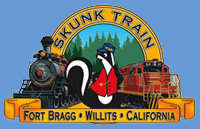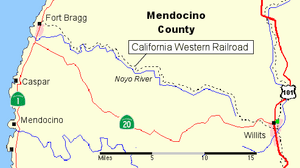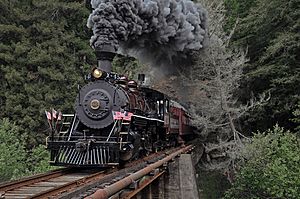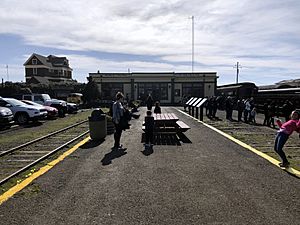California Western Railroad facts for kids
Quick facts for kids California Western Railroad |
|
|---|---|
 |
|

Map of the California Western Railroad (created using nationalatlas.gov)
|
|
| Overview | |
| Owner | Sierra Railroad |
| Locale | Mendocino County, California, U.S. |
| Termini | Ft. Bragg Willits |
| Service | |
| Type | Heritage railway |
| System | CWR |
| Services | 2 |
| Depot(s) | Fort Bragg, California, Willits, California |
| Ridership | 60,000 (2018) |
| History | |
| Opened | 1885 as Fort Bragg Railroad |
| Sold | 2003 |
| Technical | |
| Line length | 40 mi (64 km) |
| Track gauge | 4 ft 8 1⁄2 in (1,435 mm) standard gauge |
| Highest elevation | 1,740 ft (530 m) |

The California Western Railroad, also known as the Skunk Train, is a special railway in Mendocino County, California. It runs from the coastal town of Fort Bragg to Willits, California. This railway is used for both carrying goods (like freight) and for fun trips (a heritage railroad).
The Skunk Train travels through beautiful Redwood forests. It follows Pudding Creek and the Noyo River. Along the way, trains cross about 30 bridges and go through two long tunnels. A popular stop for passengers is Northspur, which is about halfway along the route.
Contents
History of the Skunk Train
Early Days and Logging
The railroad first started in 1885. It was built by the Fort Bragg Redwood Company. Its main job was to carry huge coast redwood logs from the forests to a sawmill in Fort Bragg. In 1891, the Union Lumber Company took over the railroad.
Chinese workers built the first tunnel, Tunnel No. 1, in 1893. This tunnel connected Pudding Creek to the Noyo River. By 1904, the tracks reached Alpine, and people could ride the train. They could then take a stagecoach to Willits. In 1905, the railroad changed its name to the California Western Railroad & Navigation Company. It even used ships to move lumber until 1940.
Connecting to Willits
The tracks slowly made their way up the Noyo River. They had to climb a steep hill with many sharp curves. A second tunnel, Tunnel #2, was finished in 1911. This tunnel finally connected the railway to the Northwestern Pacific Railroad in Willits. The full journey from Fort Bragg to Willits was 40 miles (64 km).
This train connection became very popular for people traveling to and from San Francisco. In 1916, a special train station was built in Willits. It looked like a building from the Tyrolean Alps.
Changes Over the Years
For a while, the railroad also had a branch line that went north along the coast. This line carried logs from the Ten Mile River to the Fort Bragg sawmill. But in 1949, trucks replaced the trains for logging on this route. Today, parts of the old railway path are used as a walking trail.
In 1947, the railroad's name was shortened to the California Western Railroad. By 1952, all the old steam locomotives were replaced with newer diesel engines.
Over the years, the railroad changed owners several times. It was owned by big lumber companies like Boise Cascade and Georgia-Pacific Corporation. In 2003, the Sierra Railroad bought the California Western Railroad. Today, it is run by Mendocino Railway, which is part of the Sierra Railroad.
The Skunk Train Route
The Skunk Train travels a 40-mile route. Here are some of the main stops and interesting features along the way:
| Milepost | Feature | Notes |
|---|---|---|
| 0 | Fort Bragg | This is where the journey starts, at the train station built in 1924. |
| 1.0 | Pudding Creek | There was a pond here that supplied water for the sawmill. |
| 3.4 | Glen Blair Junction | Near the start of Tunnel #1 (which is currently closed). |
| 6.6 | South Fork | River gravel was collected here to help build the tracks. |
| 7.3 | Rockpit | Another place where materials for the tracks were found. |
| 9.0 | Ranch | The Union Lumber Company used to raise animals here to feed their workers. |
| 10.0 | Redwood Lodge | This was once a resort, but it burned down in 1963. |
| 15.0 | Camp 3 | One of the old logging camps. |
| 16.4 | Camp Noyo | A camp run by the Boy Scouts of America. |
| 18.1 | Alpine | This place once had a hotel, school, and post office. |
| 19.0 | Camp Mendocino | A camp run by the Boys and Girls Club of San Francisco. |
| 21.3 | Northspur | This is a popular stop where trains can turn around. |
| 23.9 | Irmulco | Once a lumber company town. |
| 26.8 | Shake City | This was a place where roofing shakes (like shingles) were made. |
| 28.7 | Soda Springs | This area has special horseshoe curves in the tracks. |
| 35.4 | Summit | The highest point on the line, 1740 feet (530 m) high, inside Tunnel #2. |
| 40.0 | Willits | The end of the line, with a historic redwood train station. |
Freight and Passenger Service
In the past, the railroad mostly carried redwood lumber. It had many flatcars for logs and lumber. But by the late 1980s, lumber shipments started to decrease. More and more lumber was moved by trucks instead of trains. By 2001, all freight service stopped.
The "Skunk Train" nickname came from the gas-powered passenger cars added in 1925. People said, "You can smell 'em before you can see 'em!" because of their engines. These motorcars were very popular.
Today, the Skunk Train is mainly a tourist attraction. It uses both steam and diesel trains, as well as the special rail motor cars. The famous steam locomotive No. 45 often pulls trains on special trips. While the full trip from Fort Bragg to Willits isn't always available, shorter trips to places like Northspur or Glen Blair Junction run year-round.
Tunnel No. 1 Challenges
Tunnel No. 1, which is over 100 years old, has had some problems. In 2013, part of the tunnel collapsed, blocking the tracks. The railroad needed help to fix it. Luckily, a group called Save the Redwoods League offered money to help. This allowed the railroad to fix the tunnel and start full service again in August 2013.
The tunnel was closed again in 2016 due to damage from bad weather. This time, the railway was better prepared. They could still run trains from Willits to Northspur. From Fort Bragg, trains can go about 3.5 miles (5.6 km) to Glen Blair Junction on a trip called the "Pudding Creek Express."
The railroad is working hard to reopen Tunnel No. 1 completely. In 2018, they started offering Railbike tours, which became very popular. These are special bikes that ride on the train tracks. In 2024, the railroad received a large loan to help with repairs and upgrades. Work to reopen Tunnel #1 is expected to begin in May 2024.
Future Plans
The railroad has plans to grow! In 2019 and 2021, they bought a lot of land from the former Georgia-Pacific mill in Fort Bragg. They plan to develop this area and extend the train service to a new station there.
In Popular Culture
The Skunk Train has appeared in several movies, including The Signal Tower (1924), Racing with the Moon (1984), and The Majestic (2001). The M-300 railcar, one of the train's motor cars, is even featured in video games like Transport Fever 2.
Images for kids
-
No. 55 decorated for the United States Bicentennial.









